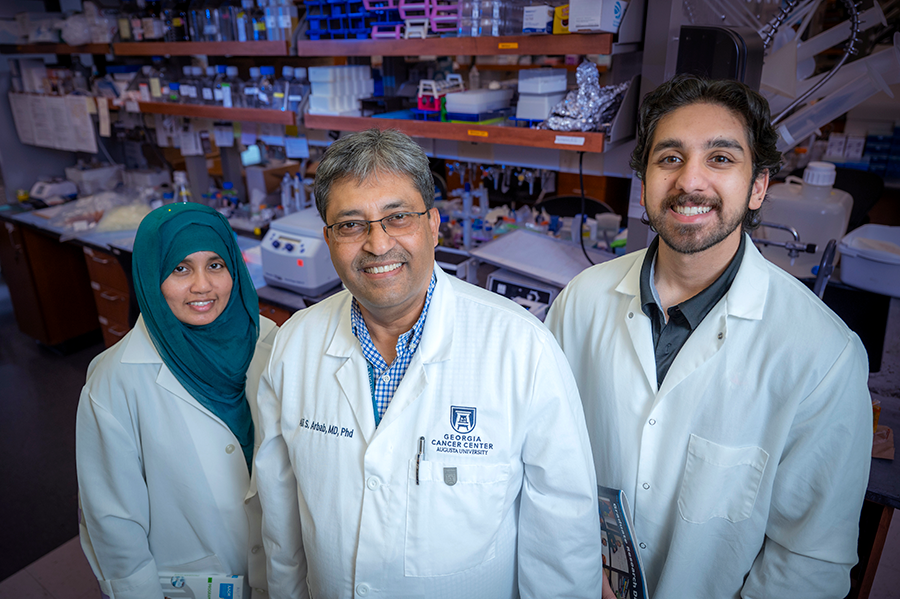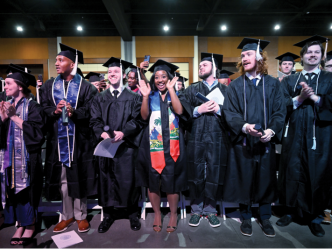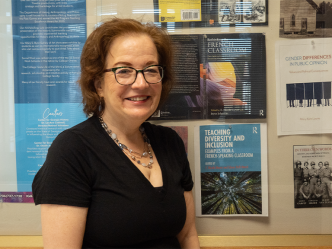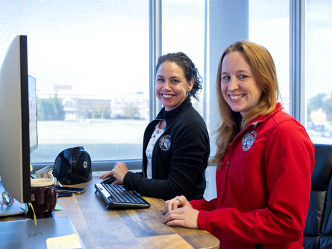In 2012, Mujibur Khan, PhD, lost his father to cancer. That loss left him wondering if there was a technological way that he could contribute to bettering treatment for cancer patients to avoid high-risk surgeries.
An opportunity arose three years later when he met Ali Arbab, MD, PhD, a professor in the Department of Biochemistry and Molecular Biology for the Medical College of Georgia at Augusta University and a researcher with the Georgia Cancer Center, at a social event in Augusta.

“In 2015, my wife received a residency offer from Augusta University, so we made the move to Augusta while I continued my work at Georgia Southern,” said Khan, an associate professor in the Department of Mechanical Engineering in the College of Engineering and Computing and the lead of the Nanomaterials Research Laboratory at Georgia Southern. “Dr. Arbab and I got to talking about the work he was doing with nanostructured-based cancer treatment models, which aligned with my current work on nanostructures.”
This past May, Arbab and Khan were the recipients of the Collaborative Seed Grant Program for Cancer Research from Georgia CORE. The $100,000 grant provides seed funding for a cancer research project involving two or more institutions in Georgia, comprised of a lead and a collaborative research entity. This funding is made possible by Georgia taxpayers who elect to donate to Georgia CORE on their tax forms.
“Funding is crucial for this type of research to be continued and for new and better treatments to be created,” Arbab said. “We cannot thank Georgia CORE enough for this.”
Nanostructures are engineered structures between the sizes of microscopic and molecular structures. They can be used for various purposes, like the nanoparticle, which can be used to carry drugs to specific targets in the body. This is what interested Arbab.

“I was working with tumor microenvironments in metastatic breast cancer and looking for a way to deliver treatment to the cancer cells directly,” said Arbab.
A tumor microenvironment is the ecosystem that surrounds a tumor and can be used by the tumor to grow and spread faster in the body. When cancer cells break off from the tumor and spread to the bloodstream or lymphatic system, then to other parts of the body, the cancer is reclassified into stage four cancer, and treatment becomes more challenging, with no “cure” available.
Arbab and Khan decided to take their knowledge and experience from their two fields and collaborate on a new way of cancer treatment using nanoparticles. The first hurdle they had to cross was encapsulating the drugs.
“A nanoparticle will not deliver drugs properly unless the drug is encapsulated,” said Arbab. “We want to deliver encapsulated drugs to the specific targets and make sure that the drug release is sustained and continuous. We want this to more effectively impact the microenvironment of the tumor than standard chemotherapy.”
Chemotherapy works by killing or slowing the growth of cancer cells, but it can also target and damage other cells that are working to fight the cancer or perform normal bodily functions. This weakens a patient, making them more susceptible to other illnesses, along with causing side effects like nausea.
“As we worked together, we began to learn what is needed to target these cells, and how we can make nano capsules act as a vehicle to carry this treatment where it needs to go and stay away from the good cells,” said Khan. “This way, we can limit the side effects on patients and prevent growth by delivering targeted therapy where it is needed most.”
By preventing growth, they can prevent cancer from becoming metastatic, improving the patients’ survival outcomes. While their current focus is on breast cancer, as 90% of breast cancer deaths are due to it becoming metastatic, this technology can be used for other invasive cancers like pancreatic cancer or glioblastoma.
Currently, Arbab and Khan are working on reducing the size of the nano capsule with the ability of the capsules to carry combinations of multiple therapeutics while also being easier for injections. It will take more time, but Arbab believes that this treatment could be available as a clinical trial in the next year or so.
“Contributing to this type of work has inspired me and has been such a wonderful opportunity for my students and me to expand upon the work we do, to explore new avenues,” said Khan. “Dr. Arbab is such a motivational person, and I am eagerly awaiting the day to see our work touch the lives of patients.”
 Augusta University
Augusta University




